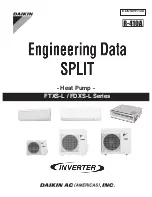
9
Condenser Coil
The condenser coil is fabricated with round tube copper hair-
pins and plate fins of various materials and/or coatings (see
Model Number Nomenclature in Appendix A to identify the
materials provided in this unit). The coil is a composite-type
two-row coil. Composite two-row coils are two single-row
coils fabricated with a single return bend end tubesheet.
Condenser Coil Maintenance and Cleaning
Recommendation
Routine cleaning of coil surfaces is essential to maintain proper
operation of the unit. Elimination of contamination and remov-
al of harmful residues will greatly increase the life of the coil
and extend the life of the unit. The following maintenance and
cleaning procedures are recommended as part of the routine
maintenance activities to extend the life of the coil.
REMOVE SURFACE LOADED FIBERS
Surface loaded fibers or dirt should be removed with a vacuum
cleaner. If a vacuum cleaner is not available, a soft non-metal-
lic bristle brush may be used. In either case, the tool should be
applied in the direction of the fins. Coil surfaces can be easily
damaged (fin edges can be easily bent over and damage to the
coating of a protected coil) if the tool is applied across the fins.
NOTE: Use of a water stream, such as a garden hose, against a
surface loaded coil will drive the fibers and dirt into the coil. This
will make cleaning efforts more difficult. Surface loaded fibers
must be completely removed prior to using low velocity clean wa-
ter rinse.
PERIODIC CLEAN WATER RINSE
A periodic clean water rinse is very beneficial for coils that are
applied in coastal or industrial environments. However, it is
very important that the water rinse is made with a very low ve-
locity water stream to avoid damaging the fin edges. Monthly
cleaning as described below is recommended. Rinsing coils in
the opposite direction of airflow is recommended.
ROUTINE CLEANING OF COIL SURFACES
Periodic cleaning with Totaline
®
environmentally balanced
coil cleaner is essential to extend the life of coils. This cleaner
is available from Replacement Components Division as part
number P902-0301 for a one gallon container, and part number
P902-0305 for a 5 gallon container. It is recommended that all
coils, including standard aluminum, pre-coated, copper/copper
or e-coated coils be cleaned with the Totaline environmentally
balanced coil cleaner as described below. Coil cleaning should
be part of the unit’s regularly scheduled maintenance proce-
dures to ensure long life of the coil. Failure to clean the coils
may result in reduced durability in the environment.
Avoid use of:
• coil brighteners
• acid cleaning prior to painting
• high pressure washers
• poor quality water for cleaning
Totaline environmentally balanced coil cleaner is nonflamma-
ble, hypo-allergenic, non-bacterial, and a USDA accepted bio-
degradable agent that will not harm the coil or surrounding
components such as electrical wiring, painted metal surfaces,
or insulation. Use of non-recommended coil cleaners is strong-
ly discouraged since coil and unit durability could be affected.
Two-Row Condenser Coils
Clean coil as follows:
1. Turn off unit power, tag disconnect.
2. Remove all screws from the top panel except the screws
securing the condenser fan to the top panel. See Fig. 14.
Fig. 14 — Location of Screws and Coil Corner Post
3. Lift and rotate the top panel at the condenser fan end and
rotate the panel 90 degrees. Support the top panel so it
remains level while resting on the condenser fan as shown
in Fig. 15.
Fig. 15 — Top Panel Position
4. Remove the compressor access panel to access the lower coil
clip. The condenser coil corner post may also be remove.
5. Remove the screws from both sides of the upper and lower
coil retaining clips on the hairpin end of the coil tube
sheets. See Fig. 16.
6. Remove the upper and lower retaining clips.
7. Draw the inner coil inward to separate the coils for cleaning.
8. Insert a spacer (field-supplied) between the tube sheets to
hold the coils apart. See Fig. 17.
9. Clean the outer coil surface to remove surface loaded fibers
or dirt. See “Remove Surface Loaded Fibers” on page 9 for
details.
10. Use a water hose or other suitable equipment to flush
down between the 2 coil sections to remove dirt and
debris. If a coil cleaner is used be sure to rinse the coils
completely before reassembly.
11. Move the inner coil back into position. Reinstall the lower
and upper coil clips. Reinstall the top panel and replace all
screws.
TOP PANEL
REMOVE SCREWS
FROM ALL SIDES
OF TOP PANEL
REMOVE
SCREWS
CONDENSER
FAN
CONDENSER
COIL
CONDENSER COIL
CORNER POST
CENTER
POST
COMPRESSOR
ACCESS PANEL
TOP PANEL
CENTER
BAFFLE
COMPRESSOR
ACCESS
PANEL
SUPPORT
(FIELD-SUPPLIED)
Содержание 551K 04N Series
Страница 15: ...15 Fig 27 Condenser Fan Assembly Screw Pattern Sequence 1 2 3 4 5 NO SCREW Blank Tab ...
Страница 82: ...82 APPENDIX D WIRING DIAGRAMS Fig E 551K 04 06 208 230 1 60 Unit with RTU Open Controller ...
Страница 83: ...83 APPENDIX D WIRING DIAGRAMS Fig F 551K 04 06 208 230 3 60 Unit with RTU Open Controller ...
Страница 84: ...84 APPENDIX D WIRING DIAGRAMS Fig G 551K 04 06 460 575 3 60 Unit with RTU Open Controller ...
Страница 85: ...85 APPENDIX D WIRING DIAGRAMS Fig H 551K 04 06 Power Wiring Diagram 208 230 1 60 ...
Страница 86: ...86 APPENDIX D WIRING DIAGRAMS Fig I 551K 04 06 Power Wiring Diagram 208 230 3 60 ...
Страница 87: ...87 APPENDIX D WIRING DIAGRAMS Fig J 551K 04 06 Power Wiring Diagram 460 575 3 60 ...
Страница 89: ......










































